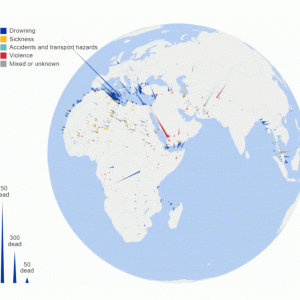About: Improving migration data
The resources gathered here support efforts to improve the quality, reliability, availability and comparability of migration data. They offer guidance and recommendations for enhancing all stages in the production of migration statistics, including the collection, analysis and sharing of migration data.
A searchable database of guidelines, handbooks, reports and other helpful documents can be accessed in the left column of this page. By using the tickbox and sliding filters, documents can be filtered according to the following categories—migration theme, type of migration data source, type of author, region of focus and date of publication. Equally, the database can be queried by typing keywords, such as “health” or “survey”, into the search field.
Why
Reliable and robust migration data and analysis are essential for evidence-based decision-making in the areas of migration and development planning. This is reflected in Agenda 2030’s Target 17.18 and the 2016 New York Declaration for Refugees and Migrants which call for high-quality and timely data to be disaggregated by a number of characteristics, including migratory status, age, and sex. In cases where these data are lacking, capacity building support is to be extended (United Nations (UN), 2015; UN, 2016a).
Many countries are unable to report on even the most basic facts and figures on migration, for example:
- Only approx. 1 in 4 countries in the world can provide the UN Statistics Division with data on international migration flows.
- In Asia only 10 of 48 countries could provide the UN with data on inflows and outflows of migrants between 2005 and 2014.
- Only 4 in 10 African countries are able to provide information on the age of migrants.
- There are no global figures indicating the scale of migrant smuggling or irregular migration (UN, 2016b).
Problems with the data may be due (but are not limited) to:
- Inconsistent and problematic definitions and concepts, which hamper comparability and broader analysis;
- Lack of awareness of where to find, and how to exploit, sources of migration data on particular migration themes or population groups of interest, such as labour migrants;
- Unfamiliarity with best practices in all stages of the production of migration statistics.
What
Resources gathered here provide guidance for, and support efforts towards, an improved understanding of:
- The collection, analysis and sharing of migration data.
- Censuses, surveys, administrative records and innovative sources of migration data.
- Migration data on a variety of migration themes, including environment, health, integration and remittances.
- Monitoring progress towards the SDGs.
This database aims to connect actors interested in improving migration data with the tools to do so. Documents are organized in such a way as to be quickly and easily located; short explanations of their contents are provided to speed up navigation, more efficiently connecting users with the information they are seeking.
In keeping with a user-oriented, time-saving design, this collection is not comprehensive. Rather, it is curated to be representative of the variety and relative abundance of available resources more broadly, with a focus on authoritative and generally applicable guidelines rather than discrete case studies.
The contents of this database therefore reflect the areas in which guidance on migration data is most commonly available and lacking. However, we welcome your suggestions of new or existing guides for inclusion. Please share your feedback here.
While there is a great deal of authoritative direction on improving long-standing types and sources of migration data, such as censuses, surveys and administrative data, similar guidance regarding the use of innovative data sources, such as big data, is relatively lacking. A rather high number of case studies and academic articles on innovative data sources were therefore included in the database in an attempt to provide users with at least a minimum degree of information on the subject.
Likewise, established migration themes and focus-areas are well attended to, especially those covered under the mandates and activities of UN agencies and other international organizations, such as child migration, forced displacement, irregular migration, labour migration, remittances and trafficking of persons. In comparison, guidance on improving the evidence-base on diasporas, human rights, migration potential, public opinion, return migration and smuggling is lacking. This may be due to their status as emerging interest areas, overlaps or gaps in institutional mandates, problems with data sources and concepts, or some combination of the above.
The most prevalent geographical area covered in the database is “global”, with 34 globally-applicable guidance materials. Regionally, Europe (15 resources) and Africa (13) are best represented, followed by Asia (6), South America (6), North America (5) and Oceania (3).
If you do find that any key documents are missing from the database, please contact us here.
Who
These materials gathered provide information and recommendations on best practices and practical approaches in the area of migration and data capacity development for the benefit of the following groups:
- Statistical officers working on the collection, analysis and reporting of migration data for policy.
- Experts and organizations engaged in capacity building activities, including design and implementation.
- Academics involved in research in migration, development or policy studies, or another related field.
Feedback
Please share your feedback on the usability of this section and if you find that any key documents are missing from the database, please contact us here.
References
United Nations
- 2016a General Assembly resolution 71/1, New York Declaration for Refugees and Migrants, A/RES/71/1 (3 October 2016)
- 2016b UN Economic and Social Council, Strengthening the demographic evidence base for the post-2015 development agenda, Commission on Population and Development, forty-ninth session, (11–15 April 2016)
- 2015 General Assembly resolution 70/1, Transforming our world: The 2030 Agenda for Sustainable Development, A/RES/70/1 (21 October 2015)

